
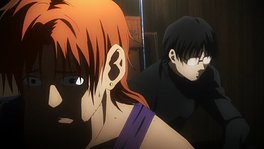
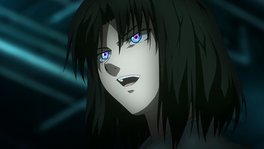
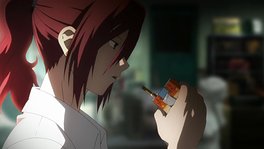
If part one of Murder Speculation was grisly, Remaining Sense of Pain is abjectly brutal. Rape, murder and torture all feature heavily in this pitch black story where a girl aggrieved slaughters her tormentors in a most barbaric fashion. Unflinching throughout, this entry in the Kara no Kyoukai series of movies explores the meaning of pain - both emotional and physical - and the nature of murder.
gone are the warm sunsets and delicately cold whites, replaced with streetlight ambers and frigid blues and greens
Mikiya is older now, Shiki has awoken from her coma and once again someone is murdering indiscriminately. After caring for a girl in pain he finds on the street, Mikiya is asked by an old school friend to track down a junior who has disappeared. Toko, after splashing out on an extravagant purchase, accepts an unsavoury job and assigns Shiki to track down the murderer. The two investigations converge when it becomes apparent the murderer, Fujino - a classmate of Mikiya's sister Azaka, is after Keita, the classmate Mikiya is tracking down. Regularly raped and beaten by Keita's gang of deviants, Fujino is massacring them one by one, but wracked by unfamiliar pain and hunted by Shiki, her power grows as her sanity slips.
Please note: the remainder of this post contains images and themes of an adult nature, if you are offended by these subjects or are otherwise restricted by laws or moral obligations within your municipality, please do not proceed.
Read the rest of this entry
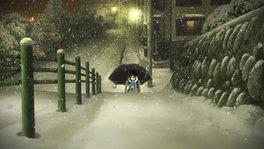

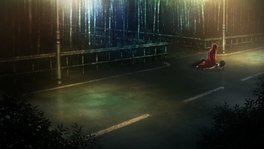

The danger with a seven movie project such as Kara no Kyoukai is that certain entries will be little more than stop-gaps meant to prime for forthcoming releases. This could be no more worrying than with a title suffixed "Part One", thoughts of incomplete plots and abrupt conclusions abound. The series has somewhat mitigated this by chronologically shuffling the releases; whereas the first movie was keen to eschew understanding for suspense and action, the second favours a sedate but no less gripping narrative that starts at the very beginning of Shiki and Mikiya's relationship.
the characters all occupy a space in the penumbra of supernatural fantasy and routine reality
Meeting by chance on a snowy evening, Mikiya - bespectacled and easy going teenager - strikes up an uneasy friendship with Shiki - a kimono-wearing misanthrope - which gradually leads to an infatuation with her. Grisly murders meanwhile are happening around town with bodies gruesomely disfigured or dissected and as the number increases, evidence points to Shiki who frequently roams the solemn town in the night time hours. Mikiya's cousin Daisuke is investigating the murders which indirectly leads to Mikiya becoming mixed up in them. Events escalate and a confrontation between Shiki and Mikiya takes a deadly turn that has long term consequences.
Read the rest of this entry
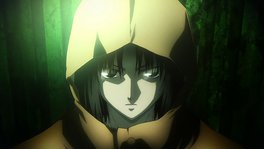
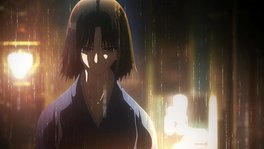
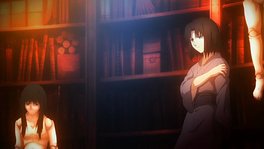
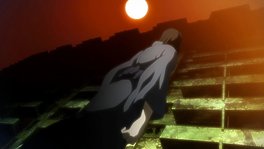
There is a sense that Kara no Kyoukai (lit. Boundary of Emptiness): Overlooking View has something to prove; eager in both presentation and story it demands to be watched. It has every right to be keen with the success of six further instalments resting on it, the first movie can't simply warm up the engine or it risks losing an audience that is unfamiliar with its Type-Moon heritage or those with only a passing interest. The result is a movie that baffles as much as it entertains by taking a matter-of-fact approach to elements which, one can only hope, will be explored elsewhere and providing a measured introduction to the kaleidoscopic beauty of the characters and universe.
a stellar opening gambit to the series and [...] is perhaps the only satisfying way Kara no Kyoukai could have started
A spate of seemingly unrelated suicides catches the attention of Touko, a red-headed pseudo-detective nestled in a chaotically organised office, who asks the acerbic Shiki to look into them. From the pre-credits scene it is clear that Shiki shares a relationship with Mikiya who now sits torpid in Touko's office, his condition linked to the derelict apartment block where the suicides occurred. Visiting the building, Shiki finds another girl who has leapt to her death and spots nine spirits floating above the building. After relaying the information to Touko, she returns only to be resolutely beaten by a powerful resident spirit. Their final confrontation takes place atop the rotting building while Touko locates the source of both the spirits and the suicides.
Read the rest of this entry
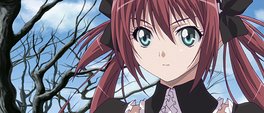



The production of a Queen's Blade anime builds on the fighting-fanservice genre championed by titles such as Ikkitousen and Tenjou Tenge and takes it to the most logical next step. The series, like the "visual combat books" preceding it, is a cynical marketing ploy, a multifaceted brothel catering to every fetish and deviance able to be safely sold to lonely, lewd or lascivious males. Discarding the comparatively coy allusions to naughtiness used in other series, Queen's Blade takes every opportunity to disrobe it's bevy of disproportionately curved females with frequent trips to hot springs, dunkings in hot oil or scattering any other liquid liberally on their persons.
This cavalcade of banality permeates the series from characters to plot
The series is perverse at it's best and represents the most saleable pornography possible: only just restraining itself from full-frontal nudity or explicit sex acts, still hiding behind outlandish situations or judiciously angled shots to retain the microscopic shred of dignity the protagonists may have. Eager not to be branded as cheap smut, there is a certain grotesque inventiveness to just how far character designs and scenes will be taken in order to eke out the most obvious innuendos or exploitive implications.
Please note: the remainder of this post contains images of nudity, if you are offended by these or are otherwise unable to view these images within your municipality due to laws or moral obligations, please do not proceed.
Read the rest of this entry
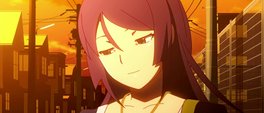

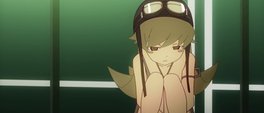

It is easy to fall in love with Bakemonogatari when looking at screenshots because for the most part, a collection of screenshots is all you receive with it - the most recent studio SHAFT / Akiyuki Shinbo series. If phrases were associated to anime, Bakemonogatari's would be "style over substance". So far does it take this maxim that it's difficult to describe any point where one feels connected or even mildly interested in the glossy puppets that fornicate with the bold colour palette.
from ice-queen cynicism to obnoxious trollop without missing a step
The story, as much as there is one, concerns Araragi who acts as a paranormal busy body for girls - ranging in age from barely legal to certainly illegal - suffering from a plethora of supernatural ailments. To aid him he regularly consults a destitute punk living in a derelict school with a outwardly pre-teen female vampire. The mythos and character back-stories are the sharpest part of the series and the afflictions suffered by the protagonists are certainly above the usual monster of the week fare, although this is perhaps thanks to the light novel source material than the anime adaptation. SHAFT and Shinbo plot their usual course and drench the series in faux abstract visuals - implying there is more meaning than is available and consequently presenting something vapid and soulless more than modern and engaging. Sudden cuts to single colour title cards start off as eccentric but quickly become a crutch to prop up the wildly varying production.
Read the rest of this entry



















